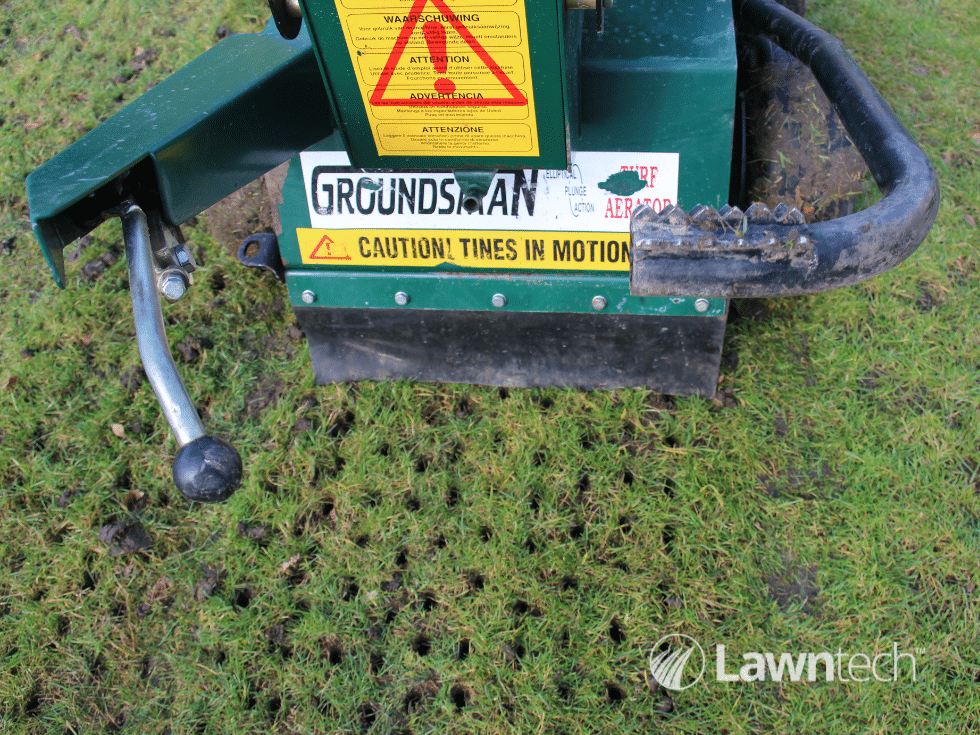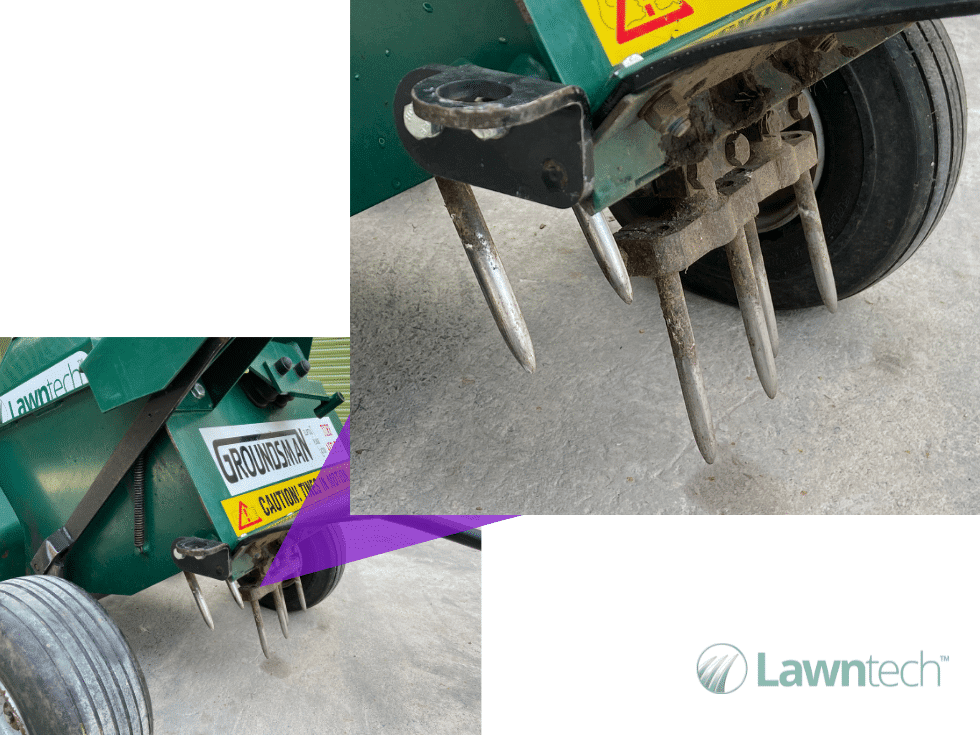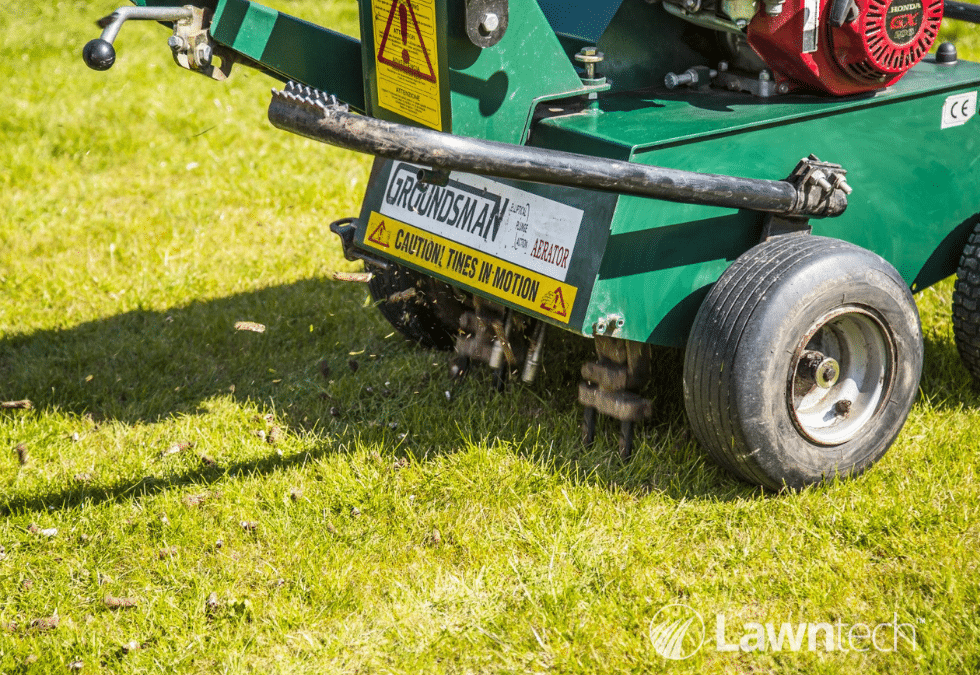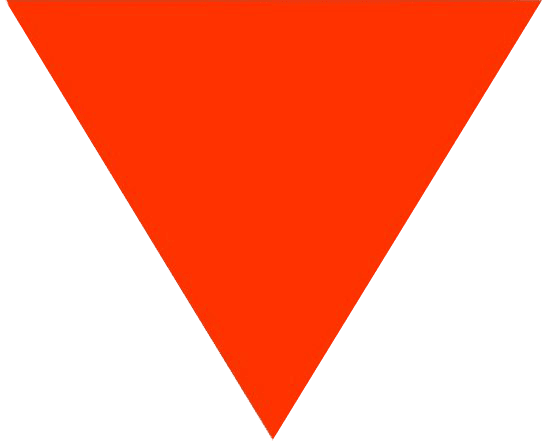My lawn needs aeration – should it be hollow tines, solid tines or slitting?
Every lawn will benefit from aeration, and here at Lawntech we always say that if there is one mechanical treatment that a lawn should have every year this would be it. Which type is best for your lawn though?
What is Aeration?
Aeration is the process of punching thousands of holes into the surface of a lawn, to relieve compaction of the soil, help the lawn to breathe in air, absorb water and take nutrients directly where it needs them most – around the roots of the grass plants that make up your lawn. Like us human beings, your lawn needs to be able to breathe to thrive, and the holes made by an aeration give it the freedom to do just that.

Pausing midway through an aeration, you can clearly see the network of holes being made by one of Lawntech’s fleet of Aerators.
When should my lawn be aerated?
Technically, aeration can be carried out at any time of year so long as the ground is soft enough to do so. This means avoiding times when the ground is frozen, waterlogged or has been baked dry by a hot summer. As a rule of thumb, we recommend aerating a lawn in autumn to help its recovery after a long summer of wear and tear and to prepare it for the winter ahead. If conditions or circumstances prevent this, a spring aeration would be a highly beneficial alternative as it will help breathe new life into the lawn after the winter.
Along with Scarification and Over-seeding, Aeration is also a cornerstone of any lawn renovation package, as it provides perfect conditions for the successful germination of new lawn seed.

Some of the soil plugs which been removed during the Aeration process. Note how the technician’s fingers cannot reach the bottom of the holes. Lawntech recommends aerating to a minimum depth of 125 – 150mm.
What is the difference between Hollow Tine, Solid Tine and Slit Aeration?
Tines are the prongs which are driven into the ground to produce the holes which bring all those benefits to your lawn. Depending on soil conditions, there is a choice of Hollow or Solid Tines and sometimes Slitting to aerate the lawn. Hollow Tines, as the name suggests, are not solid but cylindrical. They are repeatedly pushed into the ground, pulling a plug of soil (and subsurface thatch) back out with them as the aerator moves along. These are then deposited on top of the lawn and over time a little rainfall will help them to break down and return to the soil. Removing those plugs from the ground removes cores of sub-surface thatch and allows the soil and grass roots to breathe for a longer time than is the case with Solid Tine Aeration (usually several weeks more), enabling the water, oxygen and nutrients to really get to work on the lawn’s substrate, which will help to increase natural bacterial activity in the lawn.
Hollow Tine Aeration

Each Hollow Tine removes a core plug from the ground, at 450 reciprocating revolutions per minute. That’s a lot of cores!
Hollow Tine Aeration is our default method of choice, as it can be performed very successfully on the majority of lawns. It is the better solution for lawns which are heavily compacted, as its benefits are longer-lasting.
Solid Tine Aeration

Solid tines, for heavy clay soils or where regular aeration is part of a maintenance schedule.
Solid Tine Aeration comes into its own when a lawn sits on heavy clay soil, or when compaction is less severe. It is also excellent for regular, general maintenance of high-traffic lawns. The Solid Tines simply push into the ground without removing any soil, squeezing it horizontally rather than taking it out. As the tines are solid, this process is also referred to as ‘Spike Aeration’. A lawn will still benefit from Spike Aeration due to the heave caused during the process, but the effects will not be as long-lived as they are on one which has been Hollow Tined as the newly-made holes close up more readily. In some circumstances, this can be a very good thing; for example, when a speedy recovery is required.
Slit Aeration

Slice (or Slit) Aeration
Slit Aeration is the fastest and most cost effective way to create surface aeration. The slitting process root-prunes the grass plant, stimulating root growth but the tines do not go as deep as hollow tine or spiked aeration and the process is not as effective at reliving compaction. Slit aeration can be very effective on heavy clay soils, because once the soil dries out after aeration the slitting can start a fracture that will go much deeper into the soil as the clay contracts and dries, creating a potential pathway for deeper root growth.
To summarise;
Aeration can be carried out manually, using either a garden fork or purpose-built Aerator. These are available in both Hollow and Solid Tine forms but the process is very labour-intensive, so they’re best used by those who are physically fit and determined to have the exercise!
Aeration machines are available to buy and hire, in a variety of shapes and sizes. Some communities club together to hire such machines and spread the cost.
Whichever method you’re considering, we recommend aerating to a depth of at least 125 – 150mm for optimum results.
We would always advocate engaging a professional lawn specialist like Lawntech to carry out Aeration for you. All our technicians are highly skilled, experienced and trained to ensure the process is performed to the highest possible standards, thoroughly and safely, using the best quality machinery available.

Before, during an after an Aeration treatment. How the lawn benefits, in 3 stages.
Why Aerate your lawn?
Lawntech’s Top Ten Aeration benefits are:
- It relieves soil compaction
- It improves surface drainage
- It allows air into the root zone, so your lawn can breathe again
- It aids the efficient distribution of nutrients
- It helps water penetrate the soil, enabling it to reach the grass roots
- It prunes the grass roots
- It penetrates sub surface thatch
- It encourages beneficial biological activity
- It impedes moss infestation
- It promotes the dissipation of toxic chemicals
And here are our Technicians’ Top Ten Tips for a successful aeration;
- Never try to aerate when the ground is too hard (dry or frozen). This will result in stress and wear for both yourself and your machinery! If the lawn’s too dry, water it before aerating.
- Check for underground hazards before starting aeration. These can include electric cables for robotic mowers, or irrigation pipes.
- If you’re performing your aeration manually (with a garden fork or specialist tool), do so in small areas at a time. Going large can easily result in painful blisters! Also ensure you get those holes to go as deep as you can, setting yourself a minimum depth of 125mm.
- If your lawn is particularly thatchy, it may need a full renovation to give it a better chance of recovery. Lawntech offers two levels of Lawn Renovation package in addition to Aeration and/or Over-seeding. If you would like some advice on this, please follow the link to Contact Us.
- If you choose the DIY route and opt to hire a machine, be sure to shop around. There are plenty available, but not all of them are heavy duty enough to ensure they produce sufficient holes and to an adequate depth.
- Lawntech’s technicians always make several passes over a lawn when aerating. You simply cannot make too many holes in a lawn so if you’re doing it yourself, make sure you do the same.
- If you are doing your own aeration, the last thing you’ll want to see is your lawn ripping up easily as you make your first pass. This may be a telltale sign of Chafer Grubs or Leather Jackets being around, either of which will weaken the root structure of a lawn by eating the grass roots.
- Before you set out to aerate your lawn, and certainly before choosing the machinery, settle on which type of aeration is right for your lawn. Remember that hollow tines are best for all but the heavier clay soils, which are better carried out using solid tines. You can use hollow tines on heavy clay, but the cores left behind on the surface will take too long to break down so will need to be removed. This is an extra, labour-intensive chore which you can probably do without. On the other hand, the cores of lighter, sandy soils which the hollow tines produce will break down much more readily and dissolve back into the sward. If your lawn is not too thatchy, spiked aeration may well suffice, and will certainly be tidier in the immediate aftermath.
- If your lawn looks uneven once you’ve aerated, or the sward is thin it might be a good idea to brush in a top dressing of sand & loam and apply over-seeding. Lawntech offer all of these services and we’ll be happy to provide a quote, but for those keen to do the job themselves our sister company thelawnstore.co.uk can supply everything you need. These applications will promote seed germination and smooth out any minor imperfections in the lawn’s surface.
- If you’re in any doubt about which mechanical processes will be best for your lawn, you can always ask a professional company to analyse your lawn before you commit to anything. This could save you a lot of time, effort and money, while also ensuring your lawn receives the most effective treatment.
Feel free to follow the link for a quote and Lawntech’s friendly advice on all things Aeration. We’re here to help:
And here’s our video on the subject. Click on the screen to see how Lawntech goes about aerating lawns:



